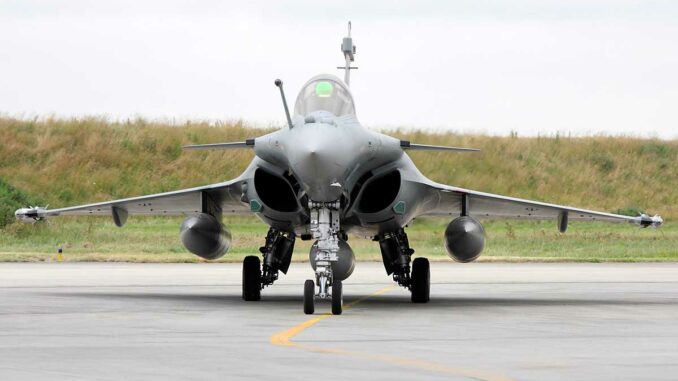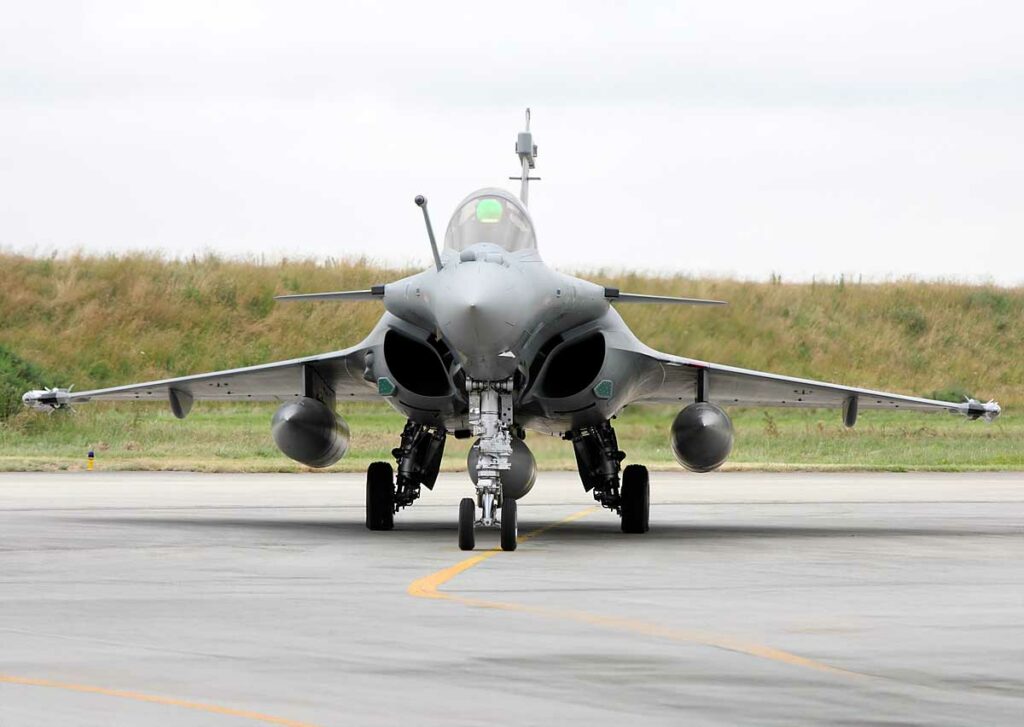
The Dassault Rafale is preparing for modernization in 2030 with increased stealth, integrated drones, and more powerful and connected weaponry.
Faced with evolving threats and the rise of Chinese, American, and Turkish air capabilities, France is preparing a complete overhaul of its multi-role fighter jet, the Dassault Rafale, by 2030. Launched in the 1980s and entered service in 2001, the Rafale remains the backbone of the French Air Force and Navy. It has established itself as an export success thanks to its versatility, reliability, and adaptability.
But by the end of this decade, new technological standards will be required: interoperability with autonomous drones, increased stealth, long-range weaponry, extended electronic warfare and a reduction in the pilot’s cognitive load. To remain competitive, Dassault Aviation, Safran, Thales, and MBDA are working on a Rafale F5 version, which will integrate coordination systems with combat drones, a new, more powerful engine, open avionics architecture, and faster, more discreet missiles.
The Rafale F5 is also seen as a strategic transition solution ahead of the SCAF (Future Air Combat System) program, scheduled for the 2040s. It will face competition from the F-35, J-20, and 6th generation projects. This modernization is not only crucial to France’s military credibility, but also to the Rafale’s position in the international combat aviation market.

A redesigned engine for more thrust and range
The modernization of the Dassault Rafale begins with an upgrade to its propulsion system. The current engine, the M88-2 designed by Safran, delivers 75 kN of thrust with afterburner. This level of performance, which was sufficient in the 2000s, is now reaching its limits in terms of meeting the requirements of extended missions with multiple external loads and keeping pace with global technological acceleration.
A joint program between Safran and the DGA (French Defense Procurement Agency) therefore aims to develop an M88-X version. This engine will offer 15 to 20% more thrust, i.e. a target of 90 kN, without significantly increasing specific fuel consumption. This improvement will enable the Rafale F5 to take off with heavier loads while maintaining its high-altitude maneuverability and extended supersonic capability.
The main challenge remains the compromise between power, weight, and service life. The new engine will have to incorporate high-temperature materials, including single-crystal alloys and ceramic coatings on the turbine blades. This will make it possible to maintain an internal temperature of over 1,800°C while complying with the cyclic maintenance constraints imposed by the armed forces.
This enhanced engine also aims to compensate for the increase in the overall weight of the Rafale F5 due to the integration of new equipment (sensors, data links, jammers, drones). It will also facilitate extended operations in twin-engine configuration or with additional fuel tanks, without compromising air combat performance.
Native integration of tactical stealth drones
One of the key features of the F5 version is the direct integration of autonomous combat drones, known as Remote Carriers, developed by Airbus and Dassault as part of the FCAS program. These drones, launched from the Rafale or operating in cooperation, will act as advanced sensors, jammers, electronic warfare platforms or autonomous attack vectors.
The Rafale F5’s avionics architecture is designed to communicate in real time with several drones via encrypted broadband links to form a dynamic tactical swarm. These smaller drones can approach enemy defenses to map their transmitters or engage targets without risk to the pilot.
This human-machine cooperation requires a new cockpit interface with increased automation of tactical management. The pilot no longer controls each drone manually, but gives overall orders to an onboard command system, which distributes tasks among the vehicles. The aim is to avoid overloading the operator while increasing offensive and survival capabilities.
The French Air Force plans to begin testing this interoperability in combined exercises as early as 2025. It aims to achieve full operational capability of the Rafale F5 with tactical drones by 2030. This building block will be essential for dealing with multi-layered defenses such as those deployed around Beijing or Kaliningrad.
A discreet evolution in stealth and radar signature
The Rafale is not a stealth fighter by design, unlike the F-35 or J-20. But its F5 upgrade aims to further reduce its radar and infrared signature without significantly altering its airframe. Dassault Aviation is working with Thales on new-generation RAM (Radar Absorbent Material) coatings that are compatible with the thermal and mechanical constraints of intensive missions.
The airframe will retain its current shape, but the new antennas, sensors, weapon bays, and leading edges will be profiled to reduce radar reflection, particularly in the X and Ku bands. The aim is not to rival a pure stealth aircraft, but to delay detection at medium range, which is sufficient to penetrate a defense system without direct confrontation.
At the same time, reducing the infrared signature is also being studied. This would involve better cooling of the engine exhaust and thermal regulation of hot surfaces. Studies are being conducted to integrate a dynamic nozzle masking system, inspired by certain devices tested on drones. The aim is to reduce the probability of interception by increasingly accurate infrared homing missiles.
Finally, the pylons and external hardpoints will be given special treatment. Mission configurations will be able to incorporate stealth aerodynamic fairings, reducing drag and radar cross section. These modifications will maintain payload flexibility without sacrificing the Rafale’s tactical range.

A modernized arsenal for air-to-ground and air-to-air superiority
The Rafale F5 will be equipped with a new range of weapons, supplied by MBDA and compliant with NATO standards. The priority is on long-range air-to-air missiles. The Meteor, already in service, remains a benchmark with a range of over 200 km. However, an upgrade is planned, with improved data link, a more selective warhead, and a dual-band homing system. This version will be able to engage stealth or maneuvering targets at very long ranges.
At the same time, a new-generation stealth air-to-ground missile is being designed to replace the SCALP-EG. It could incorporate elements of the Franco-British FMAN/FMC project, with a range of over 500 km and enhanced penetration capabilities. This vector would be compatible with Remote Carrier drones, which would serve as relays or advanced designation systems.
The internal 30 mm cannon will remain in service, but software improvements will enable better management of salvos in supersonic flight. The guided rockets (AASM) will see their accuracy increased by the addition of a backup GNSS link to compensate for GPS jamming.
This upgrade to the arsenal aims to guarantee first-strike capability in contested theaters without relying exclusively on saturation or numbers. French doctrine is based on the ability to strike quickly, precisely, and in coordination, including with NATO allies.
War Wings Daily is an independant magazine.